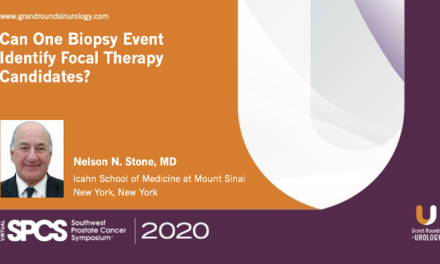Dr. M. Scott Lucia spoke at the 25th International Prostate Cancer Update on Thursday, January 22, 2015 on “Progress in Understanding the Pathology of Prostate Cancer.”
Presentation
Keywords prostate cancer, pathology, Gleason Score, biopsy
How to cite: Lucia, M. Scott. “Progress in Understanding the Pathology of Prostate Cancer.” Www.grandroundsinurology.com. March 10, 2015. Accessed [todaysdate format=”F j, Y”]. https://dev.grandroundsinurology.com/prostate-cancer-m-scott-lucia-understanding-the-pathology/.[/su_tab]
[/su_tabs]
Transcript
Progress in Understanding the Pathology of Prostate Cancer
My talk is on Progress in Understanding the Pathology of Prostate Cancer. Here’s the problem, and we’ve all known this for years. Prostate cancer natural history is a variable disease. If you really think about it, the ability of this The metastatic potential of any tumor is really the basic phenotype or the biologic aggressiveness times time. We don’t really reflect time very well in the prostate because we don’t have good imaging modalities to really follow it. We have to put a lot of emphasis on assessing the biologic aggressiveness of the tumor.
A pathologist’s role has been key in this because our ability to determine aggressiveness has really been based upon our ability to grade the cancers using the Gleason grading system either on prostatectomy or on prostate biopsy. We also use things to determine the extent of disease, stage for instance, and on biopsy the percent core is positive. But when you’re really looking at aggressiveness, there’s really a fairly finite set of tools we have to use to predict how aggressive a particular prostate cancer’s going to be.
Histologic grade has historically been our key feature here. Some of these other things that show that the tumor is aggressive and can move beyond the prostate are fairly straightforward. Now we’re starting to get into the age of molecular markers. I want to stop for a moment and really concentrate on these two areas today for the sake of time.
Here’s the Gleason grading system. I’m sure you’re all tired of hearing about the Gleason grading system, but I need to put it back up here again because really we’re moving away from the Gleason grading system and that’s the progress that’s being made in this last year or so.
What the Gleason grading system is, is the degree of invasiveness and its morphologic resemblance to normal prostate. When you look up here, you’ve got tumors that are made of acini with well-differentiated cells lining them and they’ve got this nice rounded border, meaning they’re not very infiltrative.
When you get all the way to Gleason pattern 5, you’re not making glands anymore. You’re just sheets and infiltrating cells, but all of these cells are anarchists. They’re all out for their own good and everything in between.
As we know, the classic Gleason grading system took into account the heterogeneity of prostate cancer that Gleason first discovered when the drew pictures like this. He said these tumors sometimes have mixtures of this and this and they actually behave somewhat in between the two, so he created the Gleason score, putting the most prevalent pattern and the second most prevalent pattern together.
Then along the ISUP, International Society of Urologic Pathologists, of which I’m a member, in 2005 and we started putting the evidence together to say: where are we? What do these patterns really do in the way of predicting aggressiveness of tumor? Really came up with two modifications that kind of stirred things up. One was that grades 1 and 2 really shouldn’t be used on biopsy because most of these things either weren’t cancer at all when you had tools to look at them or they got upgraded at the time of prostatectomy. You’ve got to be careful putting those on a biopsy.
The second one was on a biopsy even small amounts of high-grade tumor should be recorded in the Gleason score even if it isn’t the most prevalent or second most prevalent. There was data at the time to support this. Out of Johns Hopkins we saw that if you look at cancers that are 6 or below and that have what we call a tertiary component of a high-grade pattern, even less than 5%, pattern 4 or 5, guess what? They did worse. They did about as bad as if you would have included those in the Gleason score to begin with.
Also, if you took Gleason 7 tumors and they had just a little bit of pattern 5, they did worse. Little bits of bad Gleason pattern are important. We actually knew this 15 years ago. Damien McNeill actually looked and said it’s not so much the Gleason score that is important for prognosis; it’s how much of the tumor is pattern 4 or 5. Even small amounts of tumor portend and increased risk of biochemical recurrence.
If you really look at large studies that have looked at survival data, this study is almost 24,000 patients across five institutions looking at survival. If you can say that you’ve got a Gleason 6 or below tumor–Gleason scores of 2-6–that the survival is absolutely excellent, the black being prostate cancer-specific mortality in the study across no matter which age group that you’re looking at.
As you add progressively more pattern 4 and 5, that’s where the trouble starts. Here are 3+4 cancers, 4+3 cancers and Gleason 8 and above. The issue here is it’s the relative amount of those high-grade patterns that really influence this prognosis here.
Once again in 2013 the Johns Hopkins folks really stopped and looked at this in almost 7,900 patients. They looked at Gleason grade and said can we really show a number of different prognostic groups here? Again, if you look at the data, either when you’re grading on biopsy or on prostatectomy, and you look at the data, you can group 6 and below together and they do really quite well. Here 95% plus will go on without any biochemical recurrence. It’s only as you add increasing amounts of those high-grade patterns that you start to stratify people into different prognostic categories. Here you can see the hazard ratios compared to Gleason 6 for adding progressively more Gleason pattern 4 or 5 on your biopsy.
When we think about this in the contemporary era, does it really make sense to continue to use a 2-10 grading system? I’ll show you why. We’ve all accepted it and we understand what a Gleason 6 tumor is, but from the patient’s standpoint, it may be confusing.
We know that Gleason 6 tumor has favorable outcome. It’s low-grade tumor. But if you look at it and show this to patients, Gleason 6 is halfway between Gleason 2 and Gleason 10. It looks to the patient like they have an intermediate grade tumor. I think this contributes to reluctance to choose active surveillance.
I’ve talked to a patient who said, “6 isn’t so good, is it?” Yeah, it’s great. “Oh.” They didn’t understand that. Gleason 2 to 5 is rarely used today and not prognostically different than 6, as we’ve seen in those studies. It’s the amount of pattern 4 or 5 that’s most important for prognosis.
It’s been proposed by Epstein and colleagues that we do away with scoring and really look at prognostic groupings here. That Gleason 6 and below, that’s the best, most favorable prognostic group that we have. 3+4’s would be the second, 4+3’s would be the third, and then we start to get into 8’s–that’s the fourth–and 9 and 10, bad tumors. These are the prognostic groups that we use.
We had a meeting again. The ISUP met again November 1st in Chicago. We looked at the data. We looked at Johns Hopkins data and also data from the EAU, multi-institutional data, and really looked at this. We decided that this was the way to go. We actually voted to adopt a five-tiered system with 90% consensus for those who were there. There were 85 of us there. We also recommended that in these intermediate groups because percent of 4 and 5 is so important, that we actually record the percent of high-grade patterns be specified.
This is not out yet. The manuscript is in preparation. Stay tuned. It’s coming out. What I really see happening is we’re going to start for awhile using both Gleason score and a prognostic grade grouping just like this on our reports and eventually Gleason will fade away and we’ll be left with a very simplistic 1 to 5 grade group that actually has some meaning.
It doesn’t take away the fact that there are limitations on needle biopsy. Cancer sampling on a needle biopsy is a function of tumor volume to prostate volume. The bigger the relative tumor to the prostate volume, the more likely you are to hit it with a needle. Similarly, sampling of the high-grade component is also a function of the volume of the high-grade component as it relates to prostate volume. A very small, little bit of poor cancer can be missed.
The biopsy may not sample the highest grade. By way of illustration here, we do a lot of whole mount prostates in our institution which we can 3-dimensionally reconstruct. This is one of our 3-dimensional reconstructions. This is actually one pulled at random from over 600 of these that we have in our library. It’s a whole mount representation. I’m going to take away everything that’s benign so that you only see the tumor.
The fact is the prostate cancer is a multifocal disease process. Here we have five separate tumor foci within this prostate and all the different colors represent the heterogeneity of grade that we see within there. This makes a difference. If we have a needle come in here, I happen to know that red is pattern 3. Here we would’ve called this tumor a 3+3 cancer. Here it’s red and green. Green’s pattern 4. This would’ve been called 3+4. Just a little bit over we would’ve missed the 3 all together and we would’ve called it 4+4.
Depending on where we sample this gives you a different idea of the beast you’re dealing with. This does have consequences for the choice and potential effectiveness of expectant management for instance.
Now it comes up. Can we improve our prognostic ability through the addition of molecular biomarkers? The aggressiveness of a tumor an always be taken back to the molecular level. If we understand the molecular underpinnings of what make a tumor aggressive, then we can do better than just Gleason score. Here’s what we’re going to talk about, molecular markers or biomarkers, in here.
These are associated with a potentially aggressive tumor. We want them to be independent of Gleason grade and readily available. There are several on the market. In fact, we’ve had a boom in the last few years on molecular markers in prostate cancer. I’m only going to show a couple of examples here.
This is the so-called Prolaris test. It looks at a cell cycle progression score. It’s a gene expression array looking at the MRNA expression of 31 genes associated with the cell cycle and as they relate to 15 normalized reference genes.
In their validation study on needle biopsy, we looked at almost 350 people in a cohort that was conservatively treated in England. You can see the demographics here, median age. You can see the followup was very good. Here’s the stratification of Gleason scores on their biopsies.
The Prolaris score was highly independently prognostic of mortality within that 10-year period. In fact, when coupled with Gleason score and PSA, it actually showed improved discriminative ability to predict mortality. If you look at the prostatectomy data, this just recently came out last year. In a group of almost 600 patients here the Prolaris score was independently predictive of biochemical recurrence. You can see the hazard ratio per unit increase in Prolaris score and also metastasis-free survival. Combining something like a Prolaris test with standard pathology gives you more information than either one alone.
Another one that’s come out you heard about this morning, so I won’t get into it too much. The Oncotype DX looks at 17 gene panel. You can see the genes here cross over multiple pathways associated with metastasis, death, and prostate cancer and importantly can be looked at on a needle biopsy and be predictive of advanced pathology, unfavorable features, regardless of where you biopsy the prostate. That’s an important consideration here.
Here you’ve seen this. Here are the risk groups, NCCN very low, and intermediate risk groups, and their likelihood of having favorable pathology is defined by 3+4, and also organ-confined disease. The Prolaris score across each of these risk groups actually showed improved discriminative ability across all of them for predicting favorable pathology.
This is a more recent study looking at again another validation cohort. Again showed that the Oncotype DX and the GPS score per unit had very strong odds ratios for predicting adverse pathology at the time of radical prostatectomy. The importance of this last one is that this was also found to hold up in racial minorities. This particular study had 20% of their population was African American. You can see it held up across a lot of different clinical groups.
I’ll finish up with this. That is this is where we’ve been for many years. We’ve looked at pathologic factors like grade and extent in clinical factors and we’ve tried to make therapeutic decisions. I will tell you that I think the future is now. We’re finally starting to get molecular profiling. We add to this and improve our ability to make therapeutic decisions because we have more information, more tools in the box that tell us how a tumor is expected to behave.
References
Bishoff JT, Freedland SJ, Gerber L, et al. Prognostic utility of the cell cycle progression score generated from biopsy in men treated with prostatectomy. J Urol. 2014 Aug;192(2):409-14.
http://www.ncbi.nlim.nih.gov/pubmed/24508632
Cullen J, Rosner IL, Brand TC, et al. A Biopsy-based 17-gene Genomic Prostate Score Predicts Recurrence After Radical Prostatectomy and Adverse Surgical Pathology in a Racially Diverse Population of Men with Clinically Low- and Intermediate-risk Prostate Cancer . Eur Urol 2014 Nov 29. pii: S0302-2838(14)01213-5.
http://www.ncbi.nlim.nih.gov/pubmed/25465337
Cuzick J, Berney DM, Fisher G, et al. Prognostic value of a cell cycle progression signature for prostate cancer death in a conservatively managed needle biopsy cohort. Br J Cancer 2012 Mar 13;106(6):1095-9.
http://www.ncbi.nlim.nih.gov/pubmed/22361632
Eggener SE1, Scardino PT, Walsh PC, et al. Predicting 15-year prostate cancer specific mortality after radical prostatectomy. J Urol. 2011 Mar;185(3):869-75.
http://www.ncbi.nlim.nih.gov/pubmed/21239008
Klein EA, Yousefi K, Haddad Z, et al. A genomic classifier improves prediction of metastatic disease within 5 years after surgery in node-negative high-risk prostate cancer patients managed by radical prostatectomy without adjuvant therapy. Eur Urol. 2015 Apr;67(4):778-86.
http://www.ncbi.nlim.nih.gov/pubmed/25466945
Pan CC, Potter SR, Partin AW, et al. The prognostic significance of tertiary Gleason patterns of higher grade in radical prostatectomy specimens: a proposal to modify the Gleason grading system. Am J Surg Pathol. 2000 Apr;24(4):563-9.
http://www.ncbi.nlim.nih.gov/pubmed/10757404
Pierorazio PM, Walsh PC, Partin AW, et al. Prognostic Gleason grade grouping: data based on the modified Gleason scoring system. BJU Int. 2013 May;111(5):753-60.
http://www.ncbi.nlim.nih.gov/pubmed/23464824
Stamey TA, McNeal JE, Yemoto CM, et al.Biological determinants of cancer progression in men with prostate cancer. JAMA. 1999 Apr 21;281(15):1395-400.
http://www.ncbi.nlim.nih.gov/pubmed/10217055
ABOUT THE AUTHOR
M. Scott Lucia, MD, is Professor and Vice Chair of the Department of Pathology and Director of Anatomic Pathology and of the Prostate Diagnostic Laboratory at the University of Colorado Anschutz Medical Campus (UCAMC) School of Medicine. He also serves as the Director of the Prostate Cancer Research Laboratories at UCAMC and of the UCAMC Biorepository Core Facility. Dr. Lucia received his MD from the University of Colorado School of Medicine in 1988. He completed his internship and residency in pathology at the University of Colorado in 1993. He was a research fellow in the Laboratory of Chemoprevention at the National Institutes of Health from 1993 to 1995, before returning to the University of Colorado in 1995.
Dr. Lucia served as the primary pathologist for the Prostate Cancer Prevention Trial (PCPT) and Vitamin E and Selenium Chemoprevention Trial (SELECT), sponsored by the Southwest Oncology Group; the Medical Therapy of Prostate Symptoms (MTOPS) trial, sponsored by the NIDDK; and the Reduction with Dutasteride of Clinical Progression Events in Expectant Management of Prostate Cancer (REDEEM), sponsored by GlaxoSmithKline. He directs the operation of several tissue and serum biorepositories for prostate and prostatic diseases, including those for the PCPT, MTOPS, SELECT, and the University of Colorado Cancer Center Prostate Biorepository. He has authored or co-authored over 180 peer-reviewed articles, reviews, editorials, and book chapters. His primary areas of interest include pathology of prostate cancer and hyperplasia, early detection and prevention of prostate cancer, prostate cancer biomarkers, and mechanisms of carcinogenesis.





